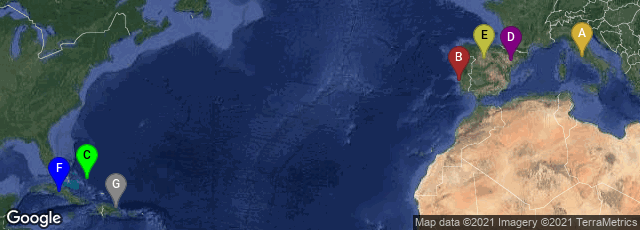
A: Roma, Lazio, Italy, B: Lisboa, Lisboa, Portugal, C: San Salvador, The Bahamas, D: Aragón, Spain, E: Valladolid, Castilla y León, Spain, F: Sancti Spíritus, Cuba, G: Samaná, Dominican Republic
Aboard the caravel Niña on February 15, 1493, sailing back from the New World, Christopher Columbus wrote an open letter to the monarchs of Spain, describing his monumental discoveries. When he docked in Lisbon on March 14, 1493 Columbus added a postscript and sent the letter to the Escribano de Racion, Luis de Santangel, finance minister to Ferdinand II and the high steward or comptroller of the king's household expenditures. Santagel had convinced Isabella I to back Columbus's voyage eight months earlier, and Santagel was the first convey the news of Columbus's success to Queen Isabella and King Ferdinand.
Santagel promptly turned over the text of Columbus's letter to printer Pedro Posa in Barcelona, and through its different printed editions which followed in close succession, Columbus's letter became the first bestselling eyewitness news account. The sequence of the earliest editions was as follows:
1. As early as April 1, 1493, Posa issued a 4-page pamphlet in small folio entitled Epistola de insulis nuper inventis (Letter on Newly Discovered Islands). Only one copy of the original printing survives. It was discovered in Spain in 1889, and passed through the hands of antiquarian bookseller Maisonneuve in Paris before reaching antiquarian bookseller Bernard Quaritch in 1890. In 1892 Quaritch sold it to the Lenox Library founded by James Lenox. This library later merged with the New York Public Library where the pamphlet is preserved today. (ISTC no. ic00756000.)
2. The second edition, published in Spanish in Valladolid, also survives only in a single copy at the Biblioteca Marciana. (ISTC no. ic00756500.)
3. The third edition, in Latin, was published in Rome by Stephen Plannck, probably in early May 1493. (ISTC no. ic00757000.) Various digital facsimiles of this edition are available.
On May 18, 2016 The New York Times reported that a copy of this edition was being returned by the Library of Congress to the Biblioteca Riccardiana Library in Florence, from which it had been stolen years ago, and replaced with a forgery. In 1990 the stolen copy was purchased by an unidientified Swiss collector, and later purchased by an unidentified New York dealer who consigned it to Christie's in New York, where it was sold in 1992 for $330,000. The copy was purchased at the auction by an unidentified private collector who donated it to the Library of Congress in 2004. The seizure warrant issued by the U.S. District Court for the District of Delaware filed on August 6, 2014 reflects an extremely high level of bibliographical sophistication and forensic analysis, distinguishing between the authentic copy which was stolen and the forged copy which remained in the Riccardiana.
4. The first illustrated edition, with woodcuts supposedly copied from drawings by Columbus, was issued by Michael Furter, for Johann Bergmann, de Olpe, in Basel, Switzerland, probably in May, 1493. (ISTC no. ic00760000.) In November 2013 a digital facsimile of the Basel 1493 edition was available from the Bayerische Staatsbibliothek at this link.
5. Giuliano Dati translated the letter into Italian verse for publication in Rome June 15, 1493. (ISTC no. id00045890). Dati's version was reprinted in Florence and Brescia in 1493. Of each printing of Dati's version only one copy survived. The Biblioteca Columbina in Seville holds the only copy of the Rome June 15, 1493 printing.
Carter & Muir, Printing and the Mind of Man (1967) no. 35.